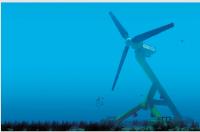 Add My Company
Add My Company
Sign In

Wave and tidal power has the potential to become the leading renewable energy resource in the United Kingdom.
Quick, what are the first energy sources that come to mind when you hear the words renewable energy? It’s likely your initial thoughts were of wind turbines and solar energy panels, but there’s a (relatively) new source with the potential to become the leading renewable energy resource in the United Kingdom; Wave and Tidal Energy.
As the name suggests, tidal energy is a form of hydropower produced by the rush of ocean waters during the rise and fall of tides. Because water is much denser than air, tidal energy is more powerful than wind energy. Additionally, unlike wind which cannot be easily predicted, tides rise and fall without fail each and every day. This produces a much more consistent and reliable source of energy than wind which can vary drastically from day to day. Another benefit worth noting is that tidal energy typically gets stronger in the winter, which happens to be the time of year when electrical needs are at their highest in the United Kingdom.
The Basics of Tidal Energy Technology
There are two main tidal technologies: stream generators and tidal barrages. Tidal stream generators (often referred to as submerged wind turbines) are mounted to the seabed and use the kinetic energy of moving water to power a turbine. In contrast, a tidal barrage is installed across a river, much like a dam. A barrage uses the constant flow of water to turn a series of turbine wheels which in turn generates power.
Although both technologies produce hydropower, there are a few differentiating factors worth considering. For one, tidal stream generators produce a more reliable, consistent source of power due to the predictability of tides we discussed previously. They are also cheaper and less damaging to the environment than the installation of barrages.
Wave & Tidal Potential in The UK
Given the vast quantities of marine energy that surround the island, the UK is in a uniquely beneficial position for wave and tidal energy production. In fact, the 11,00 miles of coastline in the UK has some of the highest tidal ranges in the world. It is estimated that more than 10GW of power can be generated from the UK’s tidal resources, which represents nearly 50% of the entire tidal energy capacity of Europe.
By 2050, the UK alone has the potential to generate up to 27GW of tidal energy, which is a major win for both affordable energy and climate change initiatives in the United Kingdom.
The Marine Renewable Deployment Fund has recognized the need to invest in this incredible potential by offering £50 million in grants to universities and businesses researching tidal energy.
The Uncertain Future
Unfortunately, as with any new technology, there are still many challenges to overcome. For example, one key predicament lies in converting the slow, oscillating motion of waves into electricity. The ocean itself represents another key problem in that its salty environment is considerably less than ideal for the long-term health of expensive energy-producing machinery.
Given the UK’s aim to reduce carbon emissions by 80% by 2050, tidal energy could become a significant contributor to clean, renewable energy. However, the hydro energy industry remains is in its infancy and has a long way to go before it can become the leading renewable resource in the country. Still, adapting turbine capabilities for hydropower installations is a challenge that many in the industry are more than keen to overcome and one that coupling manufacturer KTR has been highly involved in for more than a decade.
For more information on The Unique Potential for Wave & Tidal Energy in the UK talk to KTR U.K. Ltd
Enquire Now
List your company on FindTheNeedle.

